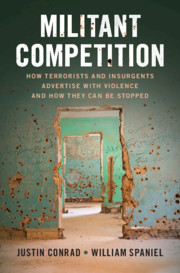 Militant Competition
Militant Competition Book contents
- Frontmatter
- Contents
- List of Tables
- List of Figures
- Acknowledgments
- 1 Introduction
- 2 A Formal Model of Outbidding
- 3 The Evidence
- 4 Outbidding, Capacity, and Government Enforcement
- 5 Outbidding as Deterrence: Endogenous Demands in the Shadow of Group Competition
- 6 Cornering the Market: Counterterrorism in the Shadow of Group Formation
- 7 Conclusion
- Bibliography
- Index
2 - A Formal Model of Outbidding
Published online by Cambridge University Press: 17 September 2021
- Frontmatter
- Contents
- List of Tables
- List of Figures
- Acknowledgments
- 1 Introduction
- 2 A Formal Model of Outbidding
- 3 The Evidence
- 4 Outbidding, Capacity, and Government Enforcement
- 5 Outbidding as Deterrence: Endogenous Demands in the Shadow of Group Competition
- 6 Cornering the Market: Counterterrorism in the Shadow of Group Formation
- 7 Conclusion
- Bibliography
- Index
Summary
This chapter develops the workhorse model we explore throughout the book. We begin by substantively motivating many aspects of competitive violence: the marketplace has limited resources, violence is costly but increases a group’s share of those resources, opposing violence decreases one’s own share, and others. These components lead us to conclude that a "contest" model is ideal to study the implications of competition. Doing so allows us to recover a central implication from existing theories of outbidding: that more groups imply more total violence output. However, our model concludes that outbidding is a collective effect rather than an individual one. Even as total violence increases in group numbers, the per-group rate of violence drops. These central results are robust to a variety of alternative assumptions.
- Type
- Chapter
- Information
- Militant CompetitionHow Terrorists and Insurgents Advertise with Violence and How They Can Be Stopped, pp. 20 - 56Publisher: Cambridge University PressPrint publication year: 2021
